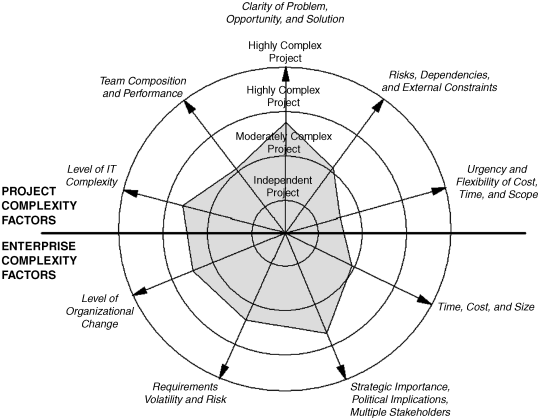The Nature of Project Complexity and Uncertainty
Kathleen B. Hass (Managing Complex Projects: A New Model, Vienna, VA: Management Concepts, 2009) offers the most in depth treatment of complexity that we have. She describes complexity in terms of:
- Time, cost, and size
- Team composition and performance
- Urgency and flexibility of cost, time, and scope
- Clarity of problem, opportunity, and solution
- Requirements volatility and risk
- Strategic importance, political implications, multiple stakeholders
- Level of organizational change
- Risks, dependencies, and external constraints
- Level of IT complexity
In a paper written shortly after her book was published (presented at the 2010 PMI Global Congress Proceedings, Washington, DC) she updates the complexity definition with a four-point scale (Independent Projects, Moderately Complex Projects, Highly Complex Projects, and Highly Complex Programs) and displays the values for a specific project in the form of a spider chart. Figure 1.1 is a hypothetical example adapted from her updated definition and published with her permission.
Figure 1.1 Project Complexity Spider Chart
Adapted from: Project Complexity Model 2.0, Kathleen B. Hass © 2010, Kathleen B. Hass & Associates, Inc.

The project illustrated in Figure 1.1 is highly complex as indicated by the project complexity score on Level of IT Complexity and Clarity of Problem, Opportunity, and Solution. ...
Get Executive's Guide to Project Management: Organizational Processes and Practices for Supporting Complex Projects now with the O’Reilly learning platform.
O’Reilly members experience books, live events, courses curated by job role, and more from O’Reilly and nearly 200 top publishers.

